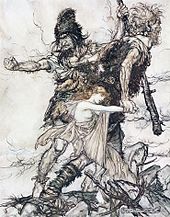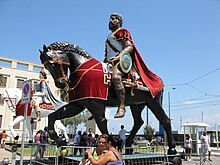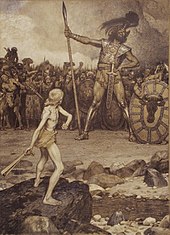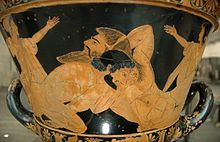Giant

The giants Fafner and Fasolt seize Freyja in Arthur Rackham's illustration of Richard Wagner's Der Ring des Nibelungen.

Giants Mata and Grifone celebrated in Messina in August, Sicily
Giants (from Latin and Ancient Greek: gigas, cognate giga-) are beings of human appearance, but of prodigious size and strength common in the mythology and legends of many different cultures. The word giant, first attested in 1297, was derived from the Gigantes (Greek: Γίγαντες[1]) of Greek mythology.
In various Indo-European mythologies, gigantic peoples are featured as primeval creatures associated with chaos and the wild nature, and they are frequently in conflict with the gods, be they Olympian, Celtic, Hindu or Norse. Giants also often play similar roles in the mythologies and folklore of other, non Indo-European peoples, such as in the Nartian traditions.
There are also accounts of giants in the Old Testament. Some of these are called Nephilim, a word often translated as giant although this translation is not universally accepted. They include Og King of Bashan, the Nephilim, the Anakim, and the giants of Egypt mentioned in 1 Chronicles 11:23. The first mention of the Nephilim is found in Genesis 6:4; attributed to them are extraordinary strength and physical proportions.
Fairy tales such as "Jack the Giant Killer" have formed the modern perception of giants as stupid and violent monsters, sometimes said to eat humans, while other giants tend to eat the livestock. The antagonist in "Jack and the Beanstalk" is often described as a giant. In some more recent portrayals, like those of Jonathan Swift and Roald Dahl, some giants are both intelligent and friendly.
Contents
1 Religion and mythology
1.1 Abrahamic mythology
1.2 Armenian mythology
1.3 Baltic mythology
1.4 Basque mythology
1.5 Bulgarian mythology
1.6 Greek mythology
1.7 Hindu mythology
1.8 Jain mythology
1.9 Native American mythologies
1.10 Norse mythology
1.11 Roman mythology
1.12 Other European mythology
2 Alleged fossil evidence
3 Names and origins of giants
4 See also
5 Notes
6 References
Religion and mythology

David faces Goliath in this 1888 lithograph by Osmar Schindler
Abrahamic mythology
Genesis tells of the Nephilim before and after Noah's Flood. According to Genesis 7:23, the Nephilim were destroyed in the Flood, but Nephilim are reported after the Flood, including:
- the Anakites[2]
- the Emites[3]
- the Amorites[4][5]
- the Rephaites[6]
The Book of Numbers[7] includes the discouraging report by the spies which Moses sent into Canaan: “We can’t attack those people; they are stronger than we are. (...) All the people we saw there are of great size. We saw the Nephilim there (the descendants of Anak come from the Nephilim). We seemed like grasshoppers in our own eyes, and we looked the same to them.” However, the Book of Joshua, describing the actual conquest of Canaan in a later generation, makes no reference to such people living there.
The Bible also tells of Gog and Magog, who later entered European folklore, and of the famous battle between David and the Philistine Goliath. While Goliath is often portrayed as a giant in retellings of the Biblical narrative, he is much smaller than other biblical giants.[citation needed] The 1st-century Jewish historian Flavius Josephus, and the 1st-2nd-century BC Dead Sea Scrolls give Goliath's height as "four cubits and a span," approximately 2.00 m or about six feet seven inches.[8] The King James translation of the Bible reports the giant Goliath as "six cubits and a span" in height—about nine feet nine inches tall, (over 2.75 m) (1Samuel 17:4 KJV), but the Septuagint, a Greek Bible, gives Goliath's height as "four cubits and a span" (~2.00 m). For comparison, the Anakites are described as making the Israelites seem like grasshoppers.[9] See also Gibborim.
Josephus also described the Amorites as giants in his Antiquities of the Jews, circa 93 AD, indicating that fossil evidence still remained at that time:[10] "For which reason they removed their camp to Hebron; and when they had taken it, they slew all the inhabitants. There were till then left the race of giants, who had bodies so large, and countenances so entirely different from other men, that they were surprising to the sight, and terrible to the hearing. The bones of these men are still shown to this very day, unlike to any credible relations of other men."[11]
In Islam, giants known as jababirat or jabbirun (Arabic: جبارون "tyrants" or "giants"; singular, Arabic: جبار Jabbar) such as Jalut (Goliath) are mentioned,[citation needed] as well as ‘Uj ibn Anaq.[citation needed]
The Book of Enoch describes giants as the offspring of Watchers and women in 7:2.[12]
Armenian mythology
Hayk was known as the founder of the Armenian state. Hayk was part of a race of giants who helped construct the tower of Babel. Ancient historian Movses Khorenatsi wrote, "Hayk was handsome and personable, with curly hair, sparkling eyes and strong arms. Among the giants he was the bravest and most famous, opponent of all who raised their hand to become absolute ruler over the giants and heroes."[13]
Mount Nemrut is known to have received its name from an Armenian tradition in which Nimrod was killed by an arrow shot by Hayk during a massive battle between two rival armies of giants to the south-east of Lake Van.[14]
Baltic mythology
According to Baltic mythology, the playing of a giantess named Neringa on the seashore formed the Curonian Spit ("neria, nerge, neringia" means land which is diving up and down like a swimmer). This character also appears in other myths (in some of which she is shown as a young strong woman, similar to a female version of the Greek Heracles). "Neringa" is the name of a modern town on the spot.
Basque mythology
Giants are rough but generally righteous characters of formidable strength living up the hills of the Basque Country. Giants stand for the Basque people reluctant to convert to Christianity who decide to stick to the old life style and customs in the forest. Sometimes they hold the secret of ancient techniques and wisdom unknown to the Christians, like in the legend of San Martin Txiki, while their most outstanding feature is their strength. It follows that in many legends all over the Basque territory the giants are held accountable for the creation of many stone formations, hills and ages-old megalithic structures (dolmens, etc.), with similar explanations provided in different spots.
However, giants show different variants and forms, they are most frequently referred to as jentilak and mairuak, while as individuals they can be represented as Basajaun ('the lord of the forests'), Sanson (development of the biblical Samson), Errolan (based on the Frankish army general Roland who fell dead at the Battle of Roncevaux Pass) or even Tartalo (a one-eyed giant akin to the Greek Cyclops).
Bulgarian mythology
In Bulgarian mythology, giants called ispolini inhabited the Earth before modern humans. They lived in the mountains, fed on raw meat and often fought against dragons. Ispolini were afraid of blackberries which posed a danger of tripping and dying, so they offered sacrifices to that plant.[15]
Greek mythology
In Greek mythology the Gigantes (γίγαντες) were (according to the poet Hesiod) the children of Uranus (Ουρανός) and Gaia (Γαία) (spirits of the sky and the earth) where some depictions had them with snake-like legs. They were involved in a conflict with the Olympian gods called the Gigantomachy (Γιγαντομαχία) when Gaia had them attack Mount Olympus. This battle was eventually settled when the hero Heracles decided to help the Olympians. The Greeks believed some of them, like Enceladus, to lay buried from that time under the earth and that their tormented quivers resulted in earthquakes and volcanic eruptions.
Herodotus in Book 1, Chapter 68, describes how the Spartans uncovered in Tegea the body of Orestes which was seven cubits long—around 10 feet (3 meters). In his book The Comparison of Romulus with Theseus Plutarch describes how the Athenians uncovered the body of Theseus, which was of more than ordinary size. The kneecaps of Ajax were exactly the size of a discus for the boy's pentathlon, wrote Pausanias. A boy's discus was about twelve centimeters in diameter, while a normal adult patella is around five centimeters, suggesting Ajax may have been around 14 feet (~4.3 meters) tall.
The Cyclopes, usually children of Gods (Olympians) and nature spirits (nereids, naiads and dryads), are also compared to giants due to their huge size (Polyphemus, son of Poseidon and Thoosa, and nemesis of Odysseus, comes to mind). The Elder Cyclopes were the children of Gaia and Uranus where they later made Zeus' Master Thunderbolt, Poseidon's Trident, and Hades' Helm of Darkness during the Titanomachy.
The Hecatoncheires are giants that have 100 arms and 50 heads who were also the children of Gaia and Uranus.
Other known giant races in Greek mythology include the six-armed Gegeines, the northern Hyperboreans, and the cannibalistic Laestrygonians.
Hindu mythology
In Hinduism, the giants are called Daityas. The Daityas (दैत्य) were the children of Diti and the sage Kashyapa who fought against the gods or Devas because they were jealous of their Deva half-brothers. Since Daityas were a power-seeking race, they sometimes allied with other races having similar ideology namely Danavas and Asuras. Daityas along with Danavas and Asuras are sometimes called Rakshasas, the generic term for a demon in Hindu mythology. Some known Daityas include Hiranyakashipu and Hiranyaksha. The main antagonist of the Hindu epic Ramayana, Ravana, was a Brahmin from his father's side and a Daitya from his mother's side. His younger brother Kumbhakarna was said to be as tall as a mountain and was quite good natured.
Jain mythology
According to Jains, there was a time when giants walked upon this earth.[16][17]Jain cosmology divides worldly cycle of time into two parts or half-cycles, avasarpani (age of descending purity) and ascending (utsarpani).[18]

Division of time as envisaged by Jains. Human beings are said to be much taller than today in the first four aras of avasarpani and last four aras of utsarpani.
According to Jain texts, the height of Rishabha, first tirthankara of present half cycle of time (avasarpani) was 500 dhanusa (longbow).[19]
In avasarpani, as the cycle moves ahead, height of all humans and animals decreases. The following table depicts the six aras of avasarpini–
| Name of the Ara | Degree of happiness | Duration of Ara | Average height of people | Average lifespan of people |
Sukhama-sukhamā | Utmost happiness and no sorrow | 400 trillion sāgaropamas | Six miles tall | Three palyopama years |
Sukhamā | Moderate happiness and no sorrow | 300 trillion sāgaropamas | Four miles tall | Two palyopama Years |
Sukhama-dukhamā | Happiness with very little sorrow | 200 trillion sāgaropamas | Two miles tall | One palyopama years |
Dukhama-sukhamā | Happiness with little sorrow | 100 trillion sāgaropamas | 1500 meters | 705.6 quintillion years |
Dukhamā | Sorrow with very little Happiness | 21,000 years | 6 feet | 130 years maximum |
Dukhama- dukhamā | Extreme sorrow and misery | 21,000 years | 2 feet | 16–20 years |
Native American mythologies
According to Paiute oral history, the Si-Te-Cah or Sai'i are a legendary tribe of red-haired cannibalistic giants, the remains of which were allegedly found in 1911 by guano miners in Nevada's Lovelock Cave.[20] Furthermore, the Paiute creation story tells of "beautiful giants" who once lived between the Sierra Nevada and the Rocky Mountains. After giving birth to a disfigured child, the giants treated the child so poorly that the Great Spirit responded by making the land hot and desolate and allowing enemies to conquer the giants. Only two giants survived: Paiute and his wife, both of whose skin became brown from eternally living in the hot desert.[21]
Adrienne Mayor writes about the Si-Te-Cah in her book, Legends of the First Americans.[22] She suggests that the 'giant' interpretation of the skeletons from Lovelock Cave and other dry caves in Nevada was started by entrepreneurs setting up tourist displays and that the skeletons themselves were of normal size. However, about a hundred miles north of Lovelock there are plentiful fossils of mammoths and cave bears, and their large limb bones could easily be thought to be those of giants by an untrained observer. She also discusses the reddish hair, pointing out that hair pigment is not stable after death and that various factors such as temperature, soil, etc. can turn ancient very dark hair rusty red or orange.
Aztec mythology features the Quinametzin, a race of giant men created in one of the previous solar eras. They are credited for the construction of Teotihuacan.
Norse mythology
In Norse mythology, the Jotun (jötnar in Old Norse, a cognate with ettin) are often opposed to the gods. While often translated as "giants", most are described as being roughly human sized. Some are portrayed as huge, such as frost giants (hrímþursar), fire giants (eldjötnar), and mountain giants (bergrisar).
The giants are the origin of most of various monsters in Norse mythology (e.g. the Fenrisulfr), and in the eventual battle of Ragnarök the giants will storm Asgard and fight them, until the world is destroyed. Even so, the gods themselves were related to the giants by many marriages, and there are giants such as Ægir, Loki, Mímir, and Skaði, who bear little difference in status to them. The Chief God Odin was the great-grand son of the Giant Ymir.
Norse mythology also holds that the entire world of men was created from the flesh of Ymir, a giant of cosmic proportions, which name is considered by some to share a root with the name Yama of Indo-Iranian mythology.
An old Icelandic legend says that two night-prowling giants, a man and a woman, were traversing the fjord near Drangey Island with their cow when they were surprised by the bright rays of daybreak. As a result of exposure to daylight, all three were turned into stone. Drangey represents the cow and Kerling (supposedly the female giant, the name means "Old Hag") is to the south of it. Karl (the male giant) was to the north of the island, but he disappeared long ago.
A bergrisi – the traditional Protector of Southwestern Iceland – appears as a supporter on the coat of arms of Iceland.
Roman mythology

Hercules faces the giant Antaios in this illustration on a calix krater, c. 515–510 BC.
Several Jupiter-Giant-Columns have been found in Germania Superior. These were crowned with a statue of Jupiter, typically on horseback, defeating or trampling down a Giant, often depicted as a snake. They are restricted to the area of south-western Germany, western Switzerland, French Jura and Alsace.
Other European mythology

King Arthur faces a giant in this engraving by Walter Crane.
In folklore from all over Europe, giants were believed to have built the remains of previous civilizations. Saxo Grammaticus, for example, argues that giants had to exist, because nothing else would explain the large walls, stone monuments, and statues that we now know were the remains of Roman construction. Similarly, the Old English poem Seafarer speaks of the high stone walls that were the work of giants. Even natural geologic features such as the massive basalt columns of the Giant's Causeway on the coast of Northern Ireland were attributed to construction by giants. Giants provided the least complicated explanation for such artifacts.
Medieval romances such as the Spanish Amadis de Gaula feature giants as antagonists, or, rarely, as allies. This is parodied famously in Cervantes' Don Quixote, when the title character attacks a windmill, believing it to be a giant. This is the source of the phrase tilting at windmills.
Tales of combat with giants were a common feature in the folklore of Wales, Scotland and Ireland. Celtic giants also figure in Breton and Arthurian romances perhaps as a reflection of the Nordic and Slavic mythology that arrived on the boats, and from this source they spread into the heroic tales of Torquato Tasso, Ludovico Ariosto, and their follower Edmund Spenser. In the small Scottish village of Kinloch Rannoch, a local myth to this effect concerns a local hill that apparently resembles the head, shoulders, and torso of a man, and has therefore been termed 'the sleeping giant'. Apparently the giant will awaken only if a specific musical instrument is played near the hill. Other giants, perhaps descended from earlier Germanic mythology, feature as frequent opponents of Dietrich von Bern in medieval German tales – in later portrayals Dietrich himself and his fellow heroes also became giants.
Many giants in English folklore were noted for their stupidity.[23] A giant who had quarreled with the Mayor of Shrewsbury went to bury the city with dirt; however, he met a shoemaker, carrying shoes to repair, and the shoemaker convinced the giant that he had worn out all the shoes coming from Shrewsbury, and so it was too far to travel.[24]
Other English stories told of how giants threw stones at each other. This was used to explain many great stones on the landscape.[25]
Giants figure in a great many fairy tales and folklore stories, such as Jack the Giant Killer, The Giant Who Had No Heart in His Body, Nix Nought Nothing, Robin Hood and the Prince of Aragon, Young Ronald, and Paul Bunyan. Ogres and trolls are humanoid creatures, sometimes of gigantic stature, that occur in various sorts of European folklore. An example of another, Slavic, folklore giant is Rübezahl, a kind giant from Wendish folklore who lived in the Giant Mountains (nowadays on the Czech–Polish border). Additionally, mythological beings which are not necessarily considered giants in the common sense can be characterized by a giant-like body size, e.g. the Bergmönch, a German mountain spirit.[26]
In Kalevala, Antero Vipunen is a giant shaman that possesses mighty spells dating to the creation. Epic hero Väinämöinen sets out to learn these spells from him, but Vipunen is buried underground, and when Väinämöinen digs him out, he is accidentally swallowed by Vipunen. Väinämöinen then forces Vipunen to submit and sing the spells out by hammering his insides. An analysis by Martti Haavio is that Vipunen is not physically large, but his familiar animal (astral form) is a whale. The depiction is not found in the majority of Finnish original stories, and most probably originates from the book's compiler Elias Lönnrot.[27]
Alleged fossil evidence
Through the centuries, certain archaeologists have searched for fossil evidence of a race of giants. Alleged evidence includes:
- The Giant of Castelnau: Estimated at 11 feet 6 inches (3.5 m) tall. Discovered by the anthropologist Georges Vacher de Lapouge at the Bronze Age cemetery of Castelnau-le-Lez, France in the winter of 1890.[28][29][30]
- 1894 press accounts mentioned a discovery of bones of human giants unearthed at a prehistoric cemetery at Montpellier, France. Skulls "28, 31, and 32 inches in circumference" were reported alongside other bones of gigantic proportions which indicated they belonged to a race of men "between 10 and 15 feet in height." The bones were reportedly sent to the Paris Academy for further study.[31][32]
- The remains of the Si-Te-Cah or Sai'i, a legendary tribe of red-haired cannibalistic giants, which were allegedly found in 1911 by guano miners in Nevada's Lovelock Cave.[20] However, the size and nature of the fossil remains has been disputed by Adrienne Mayor in the book, Fossil Legends of the First Americans.[33]
Names and origins of giants
Amorites (Hebrew)
Druon Antigoon (Belgian)
Anakim (Hebrew)
Basajaun (Basque)
Bendigeidfran (Welsh)- Bhuta (Javanese – Indonesia)
- Caligorante (France)
Cormoran (Cornwall)- Cyclopes/Cyclops (Greek)
Daidarabotchi (Japan)
Daitya (Sanskrit)
Fomorians (Gaelic)
Gigantes (Greek)
Gog (Hebrew)
Gogmagog (British)
Goliath of Gath (Hebrew)
Grendel (Anglo-Saxon)
Humbaba (Mesopotamia)
Irimũ (Kikuyu)
Ispolini (Bulgarian)
Jotuns (Norse/Teutonic)
Kalevipoeg (Estonian)
Magog (Hebrew)
Majitu (Kiswahili)
Nephilim (Hebrew)
Neringa (Lithuania) (Balt)
Og of Bashan (Hebrew)
Paul Bunyan (USA)
Raksasa (Indonesian)
Rephaim (Hebrew)
Rubezahl (Wends)
Toell the Great (Suur Tõll) (Estonia)
Si-Te-Cah (Paiute)
Tepegöz (Oghuz Turks)
Teutobochus (Teuton)
Titans (Greek)
Toell the Great (Estonian)
Yalmavuz (Turkic)
Ysbaddaden (Welsh)
Zamzummim (Hebrew)
See also
A Book of Giants
- Ruth Manning-Sanders
- Giantess
- Giants (esotericism)
- Gigantism
- Giant of Castelnau
- Half-giant
- Hindu mythology
- List of giants in mythology and folklore
- List of giants in Norse mythology
- Megafauna
- Norse mythology
- Processional giants and dragons in Belgium and France
- Somali mythology
Notes
^ γίγαντες, Georg Autenrieth, A Homeric Dictionary, on Perseus Digital Library
^ Numbers 13:28–33
^ Deuteronomy 2:10
^ Amos 2:9
^ Nave's Topical Bible: Amorites, Nave, Orville J., Retrieved:2013-03-14
^ Joshua 12:4
^ Numbers 13:28–33
^ "Variants of Bible Manuscripts". uop.edu. Archived from the original on 2008-12-27..mw-parser-output cite.citation{font-style:inherit}.mw-parser-output q{quotes:"""""""'""'"}.mw-parser-output code.cs1-code{color:inherit;background:inherit;border:inherit;padding:inherit}.mw-parser-output .cs1-lock-free a{background:url("//upload.wikimedia.org/wikipedia/commons/thumb/6/65/Lock-green.svg/9px-Lock-green.svg.png")no-repeat;background-position:right .1em center}.mw-parser-output .cs1-lock-limited a,.mw-parser-output .cs1-lock-registration a{background:url("//upload.wikimedia.org/wikipedia/commons/thumb/d/d6/Lock-gray-alt-2.svg/9px-Lock-gray-alt-2.svg.png")no-repeat;background-position:right .1em center}.mw-parser-output .cs1-lock-subscription a{background:url("//upload.wikimedia.org/wikipedia/commons/thumb/a/aa/Lock-red-alt-2.svg/9px-Lock-red-alt-2.svg.png")no-repeat;background-position:right .1em center}.mw-parser-output .cs1-subscription,.mw-parser-output .cs1-registration{color:#555}.mw-parser-output .cs1-subscription span,.mw-parser-output .cs1-registration span{border-bottom:1px dotted;cursor:help}.mw-parser-output .cs1-hidden-error{display:none;font-size:100%}.mw-parser-output .cs1-visible-error{font-size:100%}.mw-parser-output .cs1-subscription,.mw-parser-output .cs1-registration,.mw-parser-output .cs1-format{font-size:95%}.mw-parser-output .cs1-kern-left,.mw-parser-output .cs1-kern-wl-left{padding-left:0.2em}.mw-parser-output .cs1-kern-right,.mw-parser-output .cs1-kern-wl-right{padding-right:0.2em}
^ Numbers 13:33
^ Freedman, David Noel, ed., The Anchor Bible Dictionary, (New York: Doubleday, 1997, 1992).
^ Josephus, Antiquities of the Jews, Book 5, Chapter 2, Number 3, Antiquities of the Jews: Book 5, Retrieved: 15 March 2013
^ "The Book of Enoch: The Book of Enoch: Chapter VII". sacred-texts.com.
^ Khatchadourian, Arpine. David of Sassoun: An Introduction to the Study of the Armenian Epic. p. 18.
^ Collins, Andrew. From the Ashes of Angels: The Forbidden Legacy of a Fallen Race.
^ Стойнев, Анани; Димитър Попов; Маргарита Василева; Рачко Попов (2006). "Исполини". Българска митология. Енциклопедичен речник (in Bulgarian). изд. Захари Стоянов. pp. 147–148. ISBN 954-739-682-X.
^ Zimmer 1953, p. 226.
^ "Tirthankara". Encyclopædia Britannica.
^ Jain 2015, p. 175.
^ Jain 2015, p. 181.
^ ab Loud, Llewellyn L.; M. R. Harrington (15 February 1929). "Lovelock Cave". University of California Publications in American Archaeology and Ethnology (University of California at Berkeley) 25 (1): 1–183.
^ Greene, Michael S (2005). Nevada: A Journey of Discovery. Utah: Gibbs Smith. p. 39. ISBN 1-58685-139-X.
^ Mayor, Adrienne (2005). Fossil legends of the first Americans. Princeton, N.J: Princeton University Press. ISBN 0-691-11345-9.
^ Briggs 1967, p. 63.
^ Briggs 1967, p. 64.
^ Briggs 1967, p. 65.
^ Wilhelm Grimm, Jacob Grimm: Deutsche Sagen. Hamburg 2014, p. 34.
^ "Väinämöinen ja Antero Vipunen". parkkinen.org.
^ de Lapouge, G. (1890). "Le Gėant Fossile de Castelnau". La Nature. 888: 11–12. Retrieved 27 December 2010.Le sujet aurait une taille probable de 3 m, 50 [11 ft 5.8 in].
^ "A Prehistoric Giant". The Popular Science News and Boston Journal of Chemistry and Pharmacy. 24 (8): 113. August 1890. Retrieved 2011-10-27.
^ "A Race of Giants in Old Gaul" (PDF). The New York Times. October 3, 1892. Retrieved August 31, 2011.
^ "The Princeton Union (Princeton, Minn.) Pg. 2". October 11, 1894. Retrieved August 31, 2011.
^ "Giants of Prehistoric France". The McCook Tribune (McCook Neb.). March 8, 1895. p. 3. Retrieved August 31, 2011.
^ Mayor, Adrienne (2005). Fossil legends of the first Americans. Princeton, N.J: Princeton University Press.
ISBN 0-691-11345-9
References
Dictionary of Hindu Lore and Legend (
ISBN 0-500-51088-1) by Anna Dhallapiccola- Lyman, Robert R., Sr. (1971). Forbidden Land: Strange Events in the Black Forest. Vol. 1. Coudersport, PA: Potter Enterprise.
- Childress, David Hatcher (1992). Lost Cities of North & Central America. Stelle, IL: Adventures Unlimited.
- Dakhloul / Fakih debate, HHUMC (2013). Are Giants Just a Hoax?. Saida, Lebanon: Archive
- Schäfke, Werner (2015). ″Dwarves, Trolls, Ogres, and Giants″. In Albrecht Classen (Ed.): Handbook of medieval culture. Fundamental aspects and conditions of the European middle ages, vol. 1. Berlin: de Gruyter, pp. 347–383.
Zimmer, Heinrich (1953), Joseph Campbell, ed., Philosophies Of India, London, E.C. 4: Routledge & Kegan Paul Ltd, ISBN 978-8120807396
Jain, Vijay K. (2015), Acarya Samantabhadra’s Svayambhustotra: Adoration of The Twenty-four Tirthankara, Vikalp Printers, ISBN 9788190363976, archived from the original on 2015,Non-Copyright
Briggs, Katharine Mary (1967). The Fairies in English Tradition and Literature. University of Chicago Press, London. ISBN 0415286018.